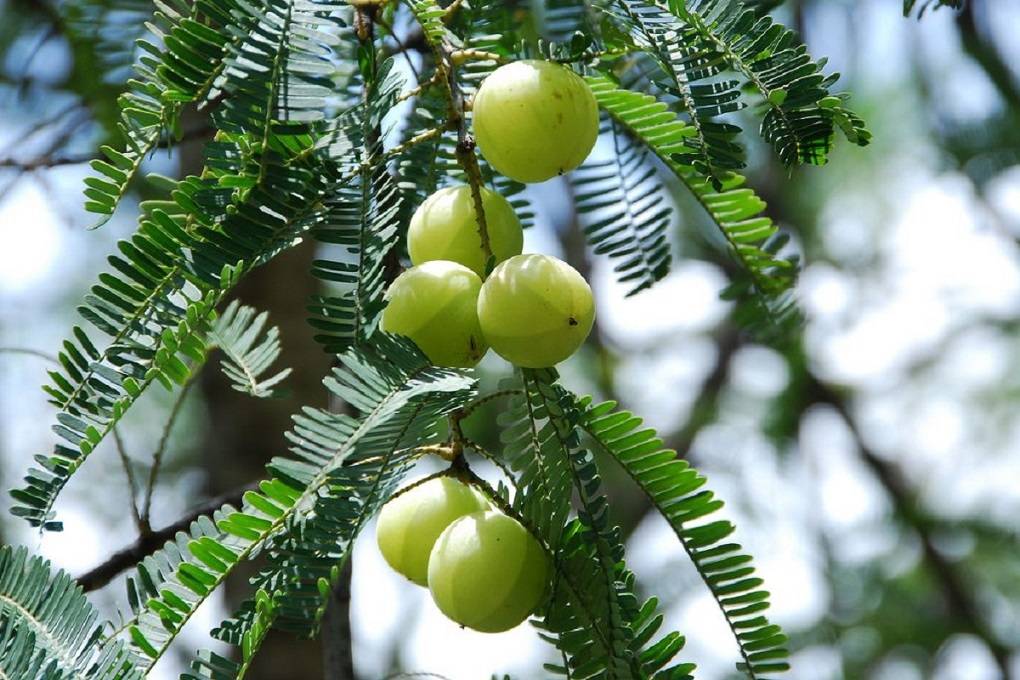
Amla, Aonla, or Indian gooseberry is a deciduous tree that is indigenous to the Indian subcontinent. While the cultivation of amla is highest in India, it is also grown in other parts of the world such as the USA, Iraq, Iran, Panama, Japan, Pakistan, China, Malaysia, Bhutan, Trinidad, and Puerto Rico.
The amla fruit is considered a superfruit as it is a rich source of vitamin C, soluble fiber, vitamin A, and antioxidants. Eating the amla fruit or drinking its juice every day has several health benefits. For instance, it helps the body regulate bowel movements, improves vision and lowers the risk of age-related macular degeneration, and improves brain function and memory. Amla also has antibacterial and anti-inflammatory properties. Therefore, it is used to treat scalp and skin-related issues.
Amla is popularly cultivated in Haryana, Himachal Pradesh, Karnataka, Madhya Pradesh, Tamil Nadu, and Uttar Pradesh. This crop prefers a dry sub-tropical climate and cannot survive in the winter season. It is also susceptible to several diseases and attracts many pests. Let’s take a look at how to manage diseases and pest infestations in amla plants.
-
Rust- Rust is a common amla disease that is prevalent in Uttar Pradesh and is responsible for major losses. It is caused by Ravenelia emblicae and causes the fruits and leaves of the plant to develop black or pinkish-brown pustules. Rust is treated by spraying wettable sulfur of Dithane- Z-78 from July-September.
-
Bark-eating caterpillar- The infestation of bark-eating caterpillars can be identified by the presence of chewed-up wood particles and irregular tunnels or patches that are covered with silken-web. Infestation from this pest causes the young shoots to dry and die. Pest management requires regularly inspecting the crop for drying young shoots, keeping the orchard clean, killing the caterpillars at the early stage of infestation, and removing webs, using cotton wools soaked in 0.025% dichlorvos or injecting water emulsion of chlorpyriphos (0.5%) to plug the holes.
-
Blue mold- Blue mold is a disease that causes brown patches and water-soaked areas on the fruit’s surface. As the infection progresses, the fruit starts to emit a bad odor and the fruit starts to develop bluish-green pustules. To manage this disease, the farmer must handle the fruit carefully to avoid bruising or injury to the fruits. It can also be treated with borax, sodium chloride, mentha oil, and carbendazim.
-
Shoot gall maker- Symptoms of shoot gall maker infestation include the swelling of terminal shoots. This infestation is managed by pruning and destroying galled shoots after harvest or spraying chlorpyriphos (0.05%) at the beginning of the season.
-
Internal Fruit Necrosis- Internal fruit necrosis is a physiological disorder that is caused by a deficiency of boron. It causes the affected fruits to turn black, become corky, and develop gummy pockets. Internal fruit necrosis is treated by spraying 0.6% of borax every 10 to 15 days between September and October.
-
Leaf-rolling caterpillar- The infestation of leaf-rolling caterpillars causes the leaves to roll inwards and this decreases their ability to perform photosynthesis. And this eventually causes the leaves to shed. Leaf-rolling caterpillar infestation is controlled by spraying 0.08% Malathion or 0.04% Monocrotophos.
-
Aphids- Aphid infestation causes the leaves to turn yellow and dry up. Untreated aphid infestation stunts the crop’s growth and affects its ability to produce flowers and fruits. Aphid infestation can be managed by clipping off and destroying affected leaves and shoots, collecting and destroying alternate weed hosts, erecting yellow pan traps, and introducing aphids’ natural predator’s ladybird beetles, green lacewings, and parasitic wasps.
Ecological engineering for pest management is a new approach to pest management that relies on cultural techniques to manipulate and control the habitat. In the amla crop, pests can be managed through crop rotations with leguminous plants, raising compatible cash crops along the border of the field to attract natural pests and avoid pest immigration, not applying broad-spectrum chemical pesticides, reducing tillage intensity, and applying a balanced dose of nutrients using biofertilizers.















